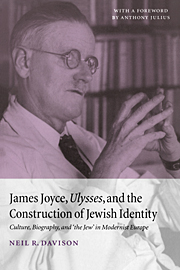 James Joyce, Ulysses, and the Construction of Jewish Identity
James Joyce, Ulysses, and the Construction of Jewish Identity Published online by Cambridge University Press: 05 April 2012
James Joyce's refigurations of a range of European cultural assumptions about “Jewishness,” as well as his confrontation of anti-Semitic nationalism, are invaluable. Joyce sought to challenge his era's dominant discourse surrounding “the Jew” by presenting a character who was a Jew, but also not a Jew, viewed both from within and from without. By imagining Bloom's conflict as one of Jewish identity, Joyce achieved an empathy for the paradoxes of Jewish marginality perhaps unequaled by any writer since. Moreover, Bloom's triumph embodies Joyce's beliefs in precisely which aspects of a positive “Jewishness” are most empowering: recognizing his own sense of Judaically-based “Jewishness” and thus rising above stereotype, Bloom the uncircumcised-converted-agnostic-cuckold re-establishes his self-respect as a Jew and as a man, and thus reaffirms his responsibility toward humanity. To read the realist novel that is Ulysses without recognizing this dynamism at the center of its narrative is, essentially, to misread Ulysses.
The idea that culture can only be re-evalutated from the position of the Other has of course become one of the intellectual staples of our age. Realizing how alienated his own sense of “Irishness” had made him to the Irish, British, and European cultures of his day, Joyce confronted his own Otherness by becoming fascinated with another type – perhaps the most entrenched “Other” in all of Europe. Bloom's final acceptance of his own “Irish-Jewishness” represents a victory for difference by demonstrating how essentialist and constructivist theories play on the act of self-making. And if the experiences of June 16 begin for Bloom a reshaping of his identity, then such a breakthrough indeed centers on his “Jewishness.”
But like Stephen Dedalus, the character who Joyce abandoned to create Bloom, the apostate author may have never solved his own conflict with Irish Catholicism.
To save this book to your Kindle, first ensure no-reply@cambridge.org is added to your Approved Personal Document E-mail List under your Personal Document Settings on the Manage Your Content and Devices page of your Amazon account. Then enter the ‘name’ part of your Kindle email address below. Find out more about saving to your Kindle.
Note you can select to save to either the @free.kindle.com or @kindle.com variations. ‘@free.kindle.com’ emails are free but can only be saved to your device when it is connected to wi-fi. ‘@kindle.com’ emails can be delivered even when you are not connected to wi-fi, but note that service fees apply.
Find out more about the Kindle Personal Document Service.
To save content items to your account, please confirm that you agree to abide by our usage policies. If this is the first time you use this feature, you will be asked to authorise Cambridge Core to connect with your account. Find out more about saving content to Dropbox.
To save content items to your account, please confirm that you agree to abide by our usage policies. If this is the first time you use this feature, you will be asked to authorise Cambridge Core to connect with your account. Find out more about saving content to Google Drive.